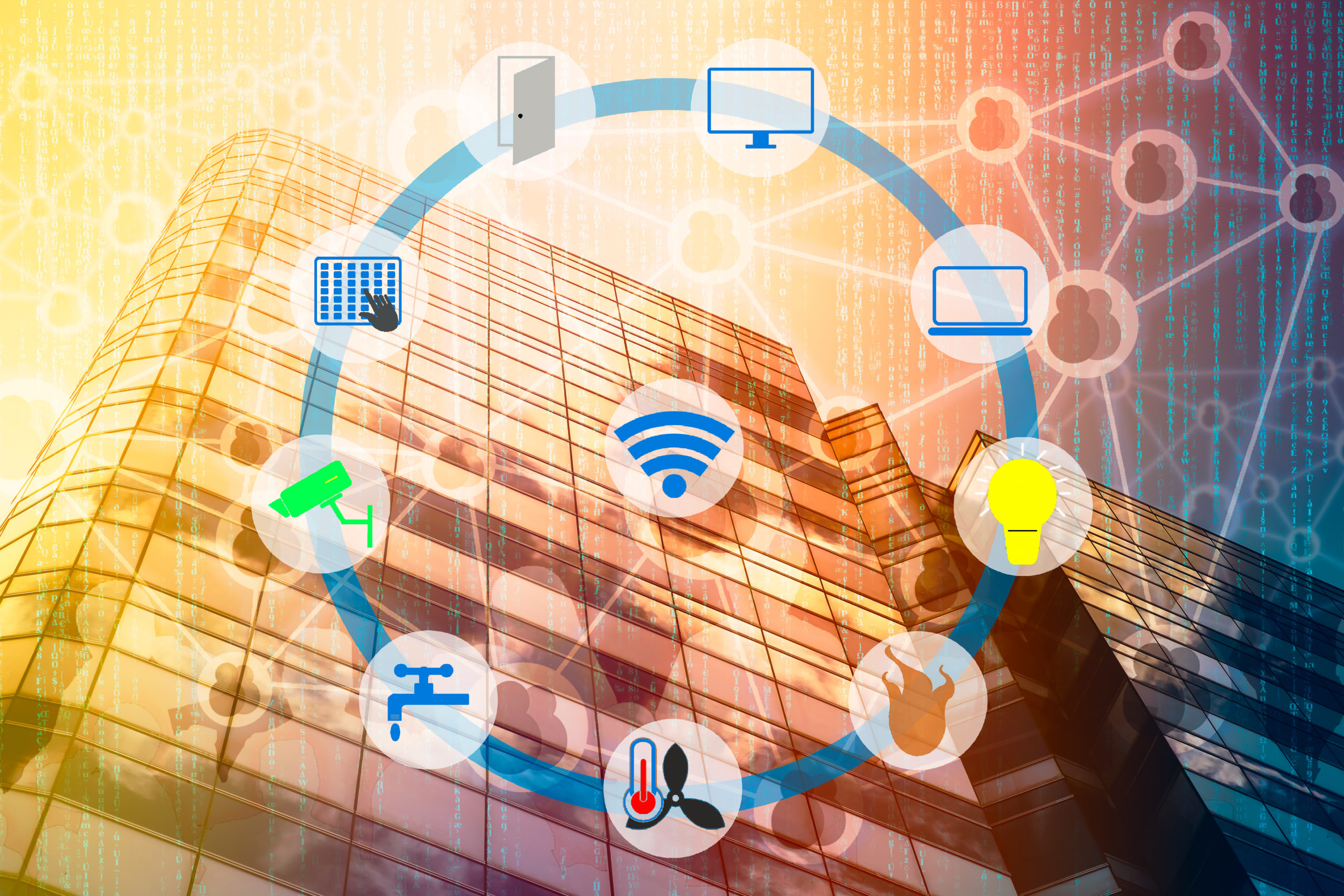
Proptech and print: natural bedfellows for the sustainable office?
April 7, 2022
Articles, Managed Print Services, Research, Smart Buildings, Sustainability, Trends
Whilst the pandemic brought the issue of climate change to the fore, to some degree, the economic impacts stalled companies’ sustainability efforts. Now, as business gets back to normal, the race is on to meet corporate commitments to reduce carbon emissions and wider ESG targets, and that’s driving new technology adoption. Smart buildings and IoT offer managed services providers the opportunity to capture new revenue opportunities – particularly to support organisations as they reconfigure and redesign their office environments post-pandemic.
Just like Fintech modernised the banking sector, Proptech has become a disruptor in the real estate market. Organisations looking to create digitally transformed, connected and eco-friendlier workplaces, are turning to smart building systems and IoT technologies that deliver advanced data and analytics capabilities for real-time feedback. Printers and smart MFPs are one of the most mature IoT devices on the network, so for MPS providers looking to grasp new growth opportunities, Print tech and Proptech could well be natural bedfellows in shaping the future sustainable office.
Reducing carbon footprint in the office
Many large corporates have set new targets to reduce their CO2 emissions in line with the UN Sustainable Development Goals (SDGs) by 2030, and as part of that pledge they are focused on reducing carbon footprint in office buildings.
And it’s easy to see why. Buildings generate nearly 40% of annual global CO2 emissions, and of those total emissions, building operations (powering lighting, heating and cooling,) are responsible for 28% annually. There’s also the impact on the bottom line – the financial cost of energy usage continues to rise – in fact in 2020, businesses were paying 50% more for power than they were in 2016.
Data-driven offices
IoT technologies that enable data capture and analysis, connectivity, monitoring and control are fast becoming the new standard for firms looking to lower the financial and environmental cost of the physical workplace.
A smart building collects, integrates and analyses data – using tools such as energy sensors or meters, building management systems or directly from HVAC systems. The data generated across these areas can provide insight into building operations – such as cost, energy usage or security monitoring.
Quocirca’s Smart Buildings and IoT research revealed that the IoT technologies most common among those already being implemented are smart heating and cooling (44%), and smart lighting (42%). And the benefits are substantial – an upgrade to a single component or isolated system can result in energy savings of 5 -15%, whereas a smart building with integrated systems can realise 30 – 50% savings in existing buildings that are otherwise inefficient.
57% of respondents indicated that lowering long-term costs was a very influential factor in IoT investment decisions. 43% of the firms surveyed cited enhancing sustainability as a very influential investment decision factor and 40% said that improving environmental performance had become a key driver due to COVID-19.
Printing, IoT and analytics
The print environment is a key area where organisations can leverage the power of analytics. Printers and smart MFPs generate a wealth of data which can be utilised by organisations to optimise their print and digital workflow processes and drive efficiencies around environmental costs.
The majority (81%), of IT decision-makers (ITDMs) surveyed by Quocirca consider print as part of their IoT environment and respondents said they want more data and environmental analytics from their printer fleet. Quocirca’s Smart Buildings and IoT report found that analytics are deemed very valuable across a range of areas – particularly process efficiency (54%), environmental metrics (54%), and the security monitoring of devices (54%).
Sustainability-related analytics are viewed as the most important for ITDMs – in particular, companies want data and analytics around energy (59%), paper usage (55%), and consumables status (50%). This is good news for traditional print manufacturers and their channel partners, as it offers opportunities to develop propositions around the broader IoT ecosystem.
Optimising energy efficiency and lowering the environmental impact of the print infrastructure will play a key role in organisations’ delivering on their sustainability strategies. Helping customers identify inefficiencies and develop targets for improvement that link to their wider environmental, social and governance (ESG) goals can be another high-profit area. MPS providers who can measure and monitor the sustainability metrics will be best positioned to take advantage of the new initiatives around smart buildings strategies.
Investment in IoT is rising
The research findings show that investment in IoT is rising, although to date the main implementations have been around the usual suspects of heating and lighting. These are fundamental to monitoring energy use, but only scratch the surface of what is possible in a fully intelligent workplace incorporating occupancy sensors, location tracking and smart logistics. Tracked in a digital twin of the physical environment, these can indicate areas of high use, areas that are underutilised and where continuous improvements can be made.
As offices re-open and the shape of hybrid, technology-enabled working emerges, there is a timely opportunity to explore the benefits that IoT implementations can deliver.
Proptech is still an emerging market, however the managed IoT services market is set to expand rapidly, as organisations recognise the value of real-time data to inform intelligent workplace strategies and provide better customer and employee experiences.
For MSPs, the ability to help customers have visibility over their buildings’ performance and operation and reduce their environmental impact around printing through leveraging data and analytics, will be a key differentiator in the commoditised managed print services market.
Proptech may be a new area but the channel has a wealth of experience in “Print tech” – the two technologies combined presents opportunity across vertical sectors from healthcare to manufacturing, retail and energy. MSPs should be looking to capture this opportunity, acquiring expertise in the sectors they plan to target through partnering with existing suppliers, or growing their own capability.




